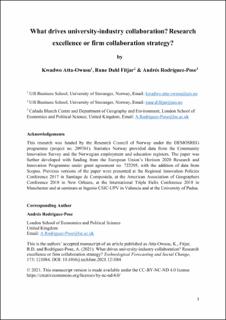| dc.contributor.author | Atta-Owusu, Kwadwo | |
| dc.contributor.author | Fitjar, Rune Dahl | |
| dc.contributor.author | Rodriguez-Pose, Andres | |
| dc.date.accessioned | 2021-11-11T10:00:23Z | |
| dc.date.available | 2021-11-11T10:00:23Z | |
| dc.date.created | 2021-11-08T17:10:29Z | |
| dc.date.issued | 2021-08-13 | |
| dc.identifier.citation | Atta-Owusu, K., Fitjar, R.D., Rodriguez-Pose, A. (2021) What drives university-industry collaboration? Research excellence or firm collaboration strategy?. Technological Forecasting and Social Change, 173, 121084 | en_US |
| dc.identifier.issn | 0040-1625 | |
| dc.identifier.uri | https://hdl.handle.net/11250/2829051 | |
| dc.description.abstract | Research and innovation policy aims to boost research output and university-industry collaboration (UIC) in part to allow firms access to leading scientific knowledge. As part of their mission, universities in many countries are expected to contribute to innovation in their regions. However, the relationship between research output and UIC is unclear: research-intensive universities can produce frontier research, which is attractive to firms, but may simultaneously suffer from a gap between the research produced and the needs of local firms, as well as mission overload. This may hinder local firms’ ability to cooperate with universities altogether or force them to look beyond the region for other suitable universities to interact with. This paper investigates the relationship between the research output of local universities and firms’ participation in UICs across different geographical scales. It uses Community Innovation Survey (CIS) data for Norwegian firms and Scopus data on Norwegian universities’ research output across various disciplines. The results demonstrate that local university research intensity and quality are negatively associated with firm participation in UICs at the local level. Firm characteristics, in particular the firm's general strategy towards cooperation and its geography, turn out to be much more important than university characteristics in explaining UICs. Notably, firms’ cooperation with other external partners at the same scale is a strong predictor of UICs. | en_US |
| dc.language.iso | eng | en_US |
| dc.publisher | Elsevier Ltd. | en_US |
| dc.rights | Attribution-NonCommercial-NoDerivatives 4.0 Internasjonal | * |
| dc.rights.uri | http://creativecommons.org/licenses/by-nc-nd/4.0/deed.no | * |
| dc.subject | økonomi | en_US |
| dc.subject | samarbeid mellom industry og universitet | en_US |
| dc.subject | forskning og innovasjon | en_US |
| dc.title | What drives university-industry collaboration? Research excellence or firm collaboration strategy? | en_US |
| dc.type | Peer reviewed | en_US |
| dc.type | Journal article | en_US |
| dc.description.version | acceptedVersion | en_US |
| dc.rights.holder | © 2021 Elsevier | en_US |
| dc.subject.nsi | VDP::Samfunnsvitenskap: 200::Økonomi: 210::Bedriftsøkonomi: 213 | en_US |
| dc.source.volume | 173 | en_US |
| dc.source.journal | Technological Forecasting and Social Change | en_US |
| dc.identifier.doi | 10.1016/j.techfore.2021.121084 | |
| dc.identifier.cristin | 1952482 | |
| dc.relation.project | EC/H2020/722295 | en_US |
| dc.relation.project | Norges forskningsråd: 209761 | en_US |
| dc.source.articlenumber | 121084 | en_US |
| cristin.ispublished | true | |
| cristin.fulltext | postprint | |
| cristin.qualitycode | 1 | |

